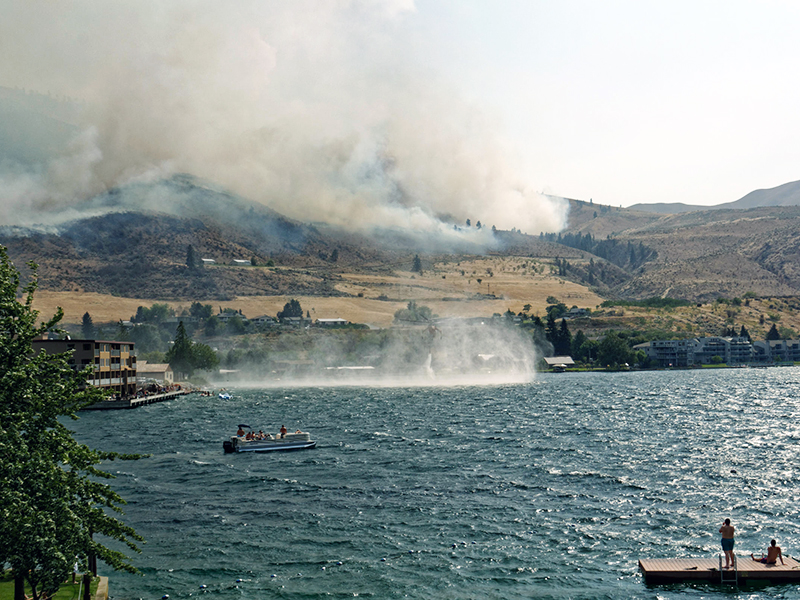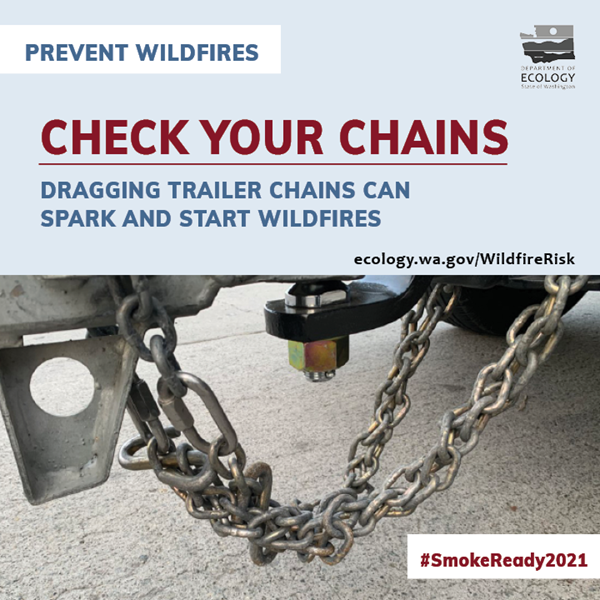
Leer la versión en español
Summer is almost here and with that comes cookouts, camping, road trips… and wildfires.
In 2020, fires across the Western United States resulted in a devastating smoke storm here in Washington that brought record-high levels of particulate pollution to nearly every part of the state. That smoke storm followed other major smoke events in 2017 and 2018. Most of us have gotten the message: It doesn’t matter where you live in Washington, you should be prepared for summer smoke from wildfires.
While wildfires are inherently unpredictable (for instance, 2019 was a mild year for wildfire smoke), the long-term trends are not good. Climate change is driving up temperatures and shrinking winter snowpack, which can lead to bigger, more damaging wildfires. Drier conditions make it easier for fires to ignite, spread more rapidly, and burn more intensely, which makes them harder to extinguish.
And, even as we work to reduce the carbon pollution that is driving climate change and creating those conditions, we need to do more to prevent wildfires. Did you know more than 80 percent of U.S. wildfires are started by people, whether by accident, negligence, or intentionally?
It takes all of us to help prevent wildfires
Preventing wildfires is something we can all do by following these simple guidelines:
- Put campfires out completely.
- Follow burn bans.
- Don't burn yard waste on windy days.
- NEVER throw cigarette butts out your window.
- Clear the perimeter of your house from pine and fir needles that can easily ignite.
- Be sure your ATV is equipped with a spark arrestor and carry an extinguisher.
- Use alternatives to burning, like composting, bagging, or chipping your yard waste.
- Never park a hot vehicle on dry grass.
- Make sure trailer chains aren’t dragging on the ground, causing sparks that can start brush fires.
Burn bans
During wildfire season, local fire departments, land managers or county emergency management agencies will call fire safety burn bans. Ecology and other air quality agencies may also call air quality burn bans when smoke levels are extremely high, but those air quality burn bans are more common in the winter months. Ecology tries to collect all burn bans of any type on our Washington burn bans website, but you should always check with local authorities before starting a campfire or any other type of burning.
Find out if there is a burn ban in your area.
If you see someone burning illegally, or if you are being impacted by smoke, report it!
Is wildfire smoke is affecting you?
Wildfire smoke is made up of gases and particulate matter that can be dangerous to your health when inhaled. Carbon monoxide is risky to people who live, work, and recreate near smoldering areas. Even if you are healthy, smoke can affect you by causing:
- Watery or dry eyes.
- Lung and sinus irritation.
- Coughing, phlegm.
- Shortness of breath and wheezing.
- Headaches.
- Irregular heartbeat, chest pain, or fatigue.
- Nonfatal and fatal heart attacks.
Symptoms may be worse for people with pre-existing health conditions. If you are in one of the groups below seek medical attention if your condition worsens.
- People with lung diseases and respiratory infections.
- People with existing heart or circulatory problems.
- People with a prior history of heart attack or stroke.
- People with diabetes.
- Infants and children under 18.
- Adults over age 65.
- Pregnant women.
- People who smoke.
Get relief from wildfire smoke
If you are indoors:
- Don’t smoke cigarettes, use candles, incense, wood stoves, or run your vacuum cleaner.
- Keep windows and doors closed. Blow a fan directly on you to keep cool.
- Use a high efficiency particulate air (HEPA) filter to reduce indoor air pollution.
- Set your air conditioner to recirculate.
- Make a low-cost, effective clean air fan.
If you are outdoors:
- If you are in a sensitive group, reconsider any outdoor activities.
- Don’t mow your lawn, fill up your gas tank, or do any strenuous activity until the air is clear.
- Protect your eyes by wearing goggles.
- Use artificial tear drops for itchy eyes.
- Drink plenty of water
- Take an over-the-counter pain reliever for headaches.
- Keep car windows rolled up and set your AC to recirculate.
- When possible, leave the area affected by smoke.
- If you must be outdoors, use an N95 respirator mask. These masks filter 95 percent of smoke particles, but they do not protect from toxic gases. Wet towels and bandanas do not provide protection from particulate matter. Respirator masks can’t protect your if they don’t fit, so children and men with beards may not benefit from a mask. If you are in a sensitive group, check with your doctor before using a mask.
Protect your pets and animals:
- Reduce their time spent in smoky areas.
- Provide them with plenty of water.
- Limit activities that will increase their breathing.
- If your pet or animal is coughing or having difficulty breathing, contact your veterinarian.
Monitor air quality, fire conditions, and smoke forecasts
State resources:
Washington Smoke Blog – The WA Smoke Blog a partnership between state, county, and federal agencies, and Indian Tribes where smoke forecasters, toxicologists and forest managers share information on current smoke concerns and forecasts.
Washington Air Quality Advisory (WAQA) – The WAQA map is a state reporting tool that is similar to the federal Air Quality Index tool. Both indexes use color-coded categories to show when air quality ranges from good to hazardous. The difference is that WAQA is based on lower levels of fine particle pollution than the federal AQI. This allows us to alert you earlier to protect your health.
Washington Smoke Forecast map – The Smoke Forecast Map predicts the amount of smoke levels in areas across Washington from wildfires and other sources up to 48 hours in advance when possible. You can use the forecast to plan outdoor activities and reduce your exposure to air pollution.
Mobile – Download the “Air Quality WA” app from the Google Play Store or Apple App store to monitor air quality in your area.
Federal resources:
Air Quality Index (AQI) – The AQI is a federal reporting tool that is similar to Washington’s WAQA reporting tool. Both use color-coded categories to show when air quality ranges from good to hazardous.
InciWeb – InciWeb is an interagency all-risk incident web information management system provided by the United States Forest Service. It was originally developed for wildland fire emergencies, but can be also used for other emergency incidents (natural disasters, such as earthquakes, floods, hurricanes, and tornadoes).
In the event your area is affected by a wildfire, have an emergency plan ready, watch for alerts, and follow evacuation orders. Visit Ready, Set, GO! for more emergency preparedness tips and have a safe and wonderful summer!


